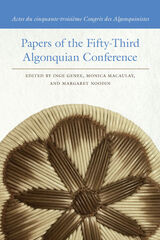477 start with D start with D

"I started out snorting a couple of lines a night and ended up injecting and snorting about three grams a day."--That could be your dentist talking.
"I worked a lot with hangovers and made lots of mistakes when coming down off acid."--That might be your nurse.
"The patient was waking up and I was out cold."--And that was some unlucky patient's anesthesiologist.
Professionals trusted with our well-being are the last people we suspect of drug addiction. And yet they are at least as likely as anyone else to abuse alcohol and other drugs--a well-kept secret finally aired and fully examined in this powerful book. Drawing on more than 120 personal interviews with addicted physicians, dentists, nurses, pharmacists, attorneys, and airline pilots and those who treat them, Robert Coombs gives us a startling picture of drug abuse among "pedestal professionals." He discusses addiction as an occupational hazard for those with the easiest access to drugs, the greatest sense of immunity to their perils, and the most extensive means (and reasons) for hiding their problems. Throughout, the interviewees' eloquent and often harrowing testimony reminds us of the human drama behind the exhaustive research and analysis presented here. Their bittersweet stories bear out Coombs's contention that recovering addicts, free of their magical elixirs, can become more complete people than they were before addiction.
From the biological, psychosocial, and spiritual roots of addiction to the equally diverse approaches to recovery, to the merits and failures of government drug policy, Drug-Impaired Professionals offers a clear and complete overview of a complex problem that affects nearly every family in America.

The medicinal properties of plants have been of interest to society for centuries and continue to be a subject of modern research. Yet too often research has been predicated upon poorly identified plant material and secondary sources of information. Much of what we know about the use of plants as drugs, poisons, foods, and as instruments of magical or religious practice derives from lore inherited from the clay tablets and papyri of the ancients and from compilations of early Greek, Arabic, and Indian physicians. Meanwhile, information pertaining to plant parts used even now in the daily life of peoples far removed from the influence of modern medical and health practices has been largely overlooked.
With the encroachment of civilized cultures on primitive societies, unique traditions—often unwritten—are being destroyed. In many instances, the very plants involved are disappearing. Not infrequently, the only record, where one exists at all, of these vanishing pools of knowledge is that of the botanical field worker. For no matter what chemical or biological investigations may follow, the botanist can affix to an actual specimen, as he collects it in the field, the local terms applied to the plant and a description of native medicinal or other uses.
Dr. Altschul has compiled field notes of health and medical interest on over 5,000 species of plants, culled from some 2,500,000 specimens of higher plants collected by field botanists from all over the world and deposited in the combined collections of the Arnold Arboretum and Gray Herbarium of Harvard University. The resulting catalogue represents a unique approach to supplying new investigational leads to researchers seeking biologically active plant principles. Dr. Altschul's meticulous sheet&ndashby–sheet examination of the Harvard collections provides the pharmacognosist, pharmacologist, and others in the medical and health sciences with an extensive firsthand survey of the domestic medicines of many cultures.
These previously unpublished botanists' notes are here made available in a comprehensive publication that should become an important resource for every investigation into the area of medicinal phytochemistry. Indexes to families and genera are provided, as well as a medical index referring to diseases and to therapeutic properties for researchers intent on locating plants with special medicinal capacities. The author is a Research Fellow at the Botanical Museum of Harvard University.

Contemporary Afro–American theatre is an exciting spectacle of an emerging black identity during a period when blacks have come to the forefront of political activity in the United States. Geneviève Fabre brings us the vast and rich production of black drama since 1945, placing it in historical and cultural context as a platform for political statement. Two strains emerge: the militant theatre of protest, and the ethnic theatre of black experience.
Militant theatre breaks free from dominant white traditions and seeks to mobilize members of the community into common action. Masks and metaphors assume their fullest meaning: when the “white masks” are torn off, “black skins” suddenly appear. At first a shout of anger and of challenge, the militant theatre later becomes an almost visionary world. The Pike of LeRoi Jones/Amiri Baraka rise like clenched fists. Among the other dramatists of militant theatre are Douglas Turner Ward, Ted Shine, Ben Caldwell, and Sonia Sanchez. We see their plays that examine relations between blacks and whites; stories of victims and rebels and traitors; and rituals of vengeance.
In contrast to the didactic speech of the militant theatre, the theatre of experience develops out of a dialogue in the language of blacks about their own experience. It embraces the rituals of daily life: the liturgy of the black church, traditional music, and folklore. This theatre celebrates a vital culture existing outside the boundaries of the dominant society. We hear the voice of the blues and the rhetoric of religion, we see depictions of the family and the street world of the ghetto, as well as the time–honored art of the trickster. James Baldwin, Ed Bullins, Melvin Van Peebles, and Edgar White are among the playwrights shown making extensive use of black cultural traditions.
Fabre is the first to attempt such an ambitious assessment of contemporary black theatre, one that evaluates its development as well as individual authors, plays, and performances, and also defines the growth of a distinctive and thriving theatrical tradition.


Water is in the air we breathe and beneath the ground we walk on. The very substance of life, it makes up as much as 60 percent of the human body. And yet, for one billion people there is such a thing as life without water. These are the people we meet in Dry--those who live in the dry lands of Africa, Asia, the Pacific, and the Americas, eking out an existence at once remarkable and mundane between craggy mountains, near oases, or close to well-springs surrounded by cracked earth or shifting sands.
From the ingenuity of the highland people of Chile's Atacama desert who use giant nets to capture water from clouds of fog, to the ancient wisdom that protects the grazing lands of Kenya's Masai, this beautifully illustrated book tells the diverse stories about people in very hot, very cold, or very high places, who spend their lives collecting, chasing, piping, and trapping the water that life requires--all the while taking great care that no form of life, plant or animal, benefits at the expense of another.
In a world of finite resources, where the struggle for shrinking sources of water intensifies daily, these stories--collected over three years by photographers, writers, and scientists from four continents--are a source of hope and wonder. This book contains a wealth of information and images designed to further awareness of the vast array of life that is carried on precariously yet proudly on the earth's dryest lands.

In 1919, the United States embarked on the country’s boldest attempt at moral and social reform: Prohibition. The 18th Amendment to the Constitution prohibited the manufacture, transportation, and sale of alcohol around the country. This “noble experiment,” as President Hoover called it, was intended to usher in a healthier, more moral, and more efficient society. Nowhere was such reform needed more, proponents argued, than in New York City—and nowhere did Prohibition fail more spectacularly. Dry Manhattan is the first major work on Prohibition in nearly a quarter century, and the only full history of Prohibition in the era’s most vibrant city.
Though New Yorkers were cautiously optimistic at first, Prohibition quickly degenerated into a deeply felt clash of cultures that utterly transformed life in the city. Impossible to enforce, the ban created vibrant new markets for illegal alcohol, spawned corruption and crime, fostered an exhilarating culture of speakeasies and nightclubs, and exposed the nation’s deep prejudices. Writ large, the conflict over Prohibition, Michael Lerner demonstrates, was about much more than the freedom to drink. It was a battle between competing visions of the United States, pitting wets against drys, immigrants against old stock Americans, Catholics and Jews against Protestants, and proponents of personal liberty against advocates of societal reform.
In his evocative history, Lerner reveals Prohibition to be the defining issue of the era, the first major “culture war” of the twentieth century, and a harbinger of the social and moral debates that divide America even today.

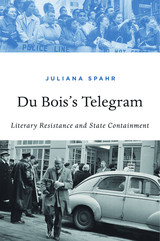
In 1956 W. E. B. Du Bois was denied a passport to attend the Présence Africaine Congress of Black Writers and Artists in Paris. So he sent the assembled a telegram. “Any Negro-American who travels abroad today must either not discuss race conditions in the United States or say the sort of thing which our State Department wishes the world to believe.” Taking seriously Du Bois’s allegation, Juliana Spahr breathes new life into age-old questions as she explores how state interests have shaped U.S. literature. What is the relationship between literature and politics? Can writing be revolutionary? Can art be autonomous, or is escape from nations and nationalisms impossible?
Du Bois’s Telegram brings together a wide range of institutional forces implicated in literary production, paying special attention to three eras of writing that sought to defy political orthodoxies by contesting linguistic conventions: avant-garde modernism of the early twentieth century; social-movement writing of the 1960s and 1970s; and, in the twenty-first century, the profusion of English-language works incorporating languages other than English. Spahr shows how these literatures attempted to assert their autonomy, only to be shut down by FBI harassment or coopted by CIA and State Department propagandists. Liberal state allies such as the Ford and Rockefeller foundations made writers complicit by funding multiculturalist works that celebrated diversity and assimilation while starving radical anti-imperial, anti-racist, anti-capitalist efforts.
Spahr does not deny the exhilarations of politically engaged art. But her study affirms a sobering reality: aesthetic resistance is easily domesticated.

Often considered China’s greatest poet, Du Fu (712–770) came of age at the height of the Tang dynasty, in an era marked by confidence that the accumulated wisdom of the precedent cultural tradition would guarantee civilization’s continued stability and prosperity. When his society collapsed into civil war in 755, however, he began to question contemporary assumptions about the role that tradition should play in making sense of experience and defining human flourishing.
In this book, Lucas Bender argues that Du Fu’s reconsideration of the nature and importance of tradition has played a pivotal role in the transformation of Chinese poetic understanding over the last millennium. In reimagining his relationship to tradition, Du Fu anticipated important philosophical transitions from the late-medieval into the early-modern period and laid the template for a new and perduring paradigm of poetry’s relationship to ethics. He also looked forward to the transformations his own poetry would undergo as it was elevated to the pinnacle of the Chinese poetic pantheon.

As her little boy plays at a day care center across the street, Michelle, an unmarried teenager, is in algebra class, hoping to be the first member of her family to graduate from high school. Will motherhood make this young woman poorer? Will it make the United States poorer as a nation? That's what the voices raised against "babies having babies" would have us think, and what many Americans seem inclined to believe. This powerful book takes us behind the stereotypes, the inflamed rhetoric, and the flip media sound bites to show us the complex reality and troubling truths of teenage mothers in America today.
Would it surprise you to learn that Michelle is more likely to be white than African American? That she is most likely eighteen or nineteen--a legal adult? That teenage mothers are no more common today than in 1900? That two-thirds of them have been impregnated by men older than twenty? Kristin Luker, author of the acclaimed Abortion and the Politics of Motherhood, puts to rest once and for all some very popular misconceptions about unwed mothers from colonial times to the present. She traces the way popular attitudes came to demonize young mothers and examines the profound social and economic changes that have influenced debate on the issue, especially since the 1970s. In the early twentieth century, reformers focused people's attention on the social ills that led unmarried teenagers to become pregnant; today, society has come almost full circle, pinning social ills on sexually irresponsible teens.
Dubious Conceptions introduces us to the young women who are the object of so much opprobrium. In these pages we hear teenage mothers from across the country talk about their lives, their trials, and their attempts to find meaning in motherhood. The book also gives a human face to those who criticize them, and shows us why public anger has settled on one of society's most vulnerable groups. Sensitive to the fears and confusion that fuel this anger, and to the troubled future that teenage mothers and their children face, Luker makes very clear what we as a nation risk by not recognizing teenage pregnancy for what it is: a symptom, not a cause, of poverty.

On Easter Monday 1916, while much of Dublin holidayed at the seaside and placed bets at the horse races, a disciplined group of Irish Volunteers seized the city’s General Post Office in what would become the defining act of rebellion against British rule—and the most significant single event in modern Irish history. By week’s end, the rebels had surrendered, and the siege had left the once magnificent GPO an empty shell—and turned it into the most famous and deeply symbolic building in all of Ireland.
This book unravels the events in and around the GPO during the Easter Rising of 1916. Drawing on participant and eyewitness accounts, diaries, and newspaper reports, Clair Wills recreates the harrowing moments that transformed the GPO from an emblem of nineteenth-century British power and civil government, to an embattled barricade, and finally to a national symbol. What was it like to be trapped in the building? To watch, and listen to, the destruction of the city? Was the act meant as a bloody sacrifice or a military coup d’état? Exploring these questions as they were experienced and understood then and later, her book reveals the twists and turns that the myth of the GPO has undergone in the last century, as it has stood for sacrifice and treachery, national unity and divisive violence, the future and the past.
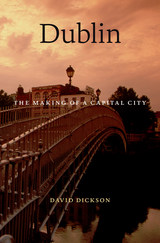
Dublin has experienced great—and often astonishing—change in its 1,400 year history. It has been the largest urban center on a deeply contested island since towns first appeared west of the Irish Sea. There have been other contested cities in the European and Mediterranean world, but almost no European capital city, David Dickson maintains, has seen sharper discontinuities and reversals in its history—and these have left their mark on Dublin and its inhabitants. Dublin occupies a unique place in Irish history and the Irish imagination. To chronicle its vast and varied history is to tell the story of Ireland.
David Dickson’s magisterial history brings Dublin vividly to life beginning with its medieval incarnation and progressing through the neoclassical eighteenth century, when for some it was the “Naples of the North,” to the Easter Rising that convulsed a war-weary city in 1916, to the bloody civil war that followed the handover of power by Britain, to the urban renewal efforts at the end of the millennium. He illuminates the fate of Dubliners through the centuries—clergymen and officials, merchants and land speculators, publishers and writers, and countless others—who have been shaped by, and who have helped to shape, their city. He reassesses 120 years of Anglo-Irish Union, during which Dublin remained a place where rival creeds and politics struggled for supremacy. A book as rich and diverse as its subject, Dublin reveals the intriguing story behind the making of a capital city.

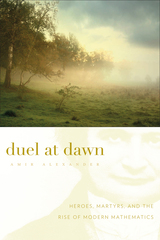
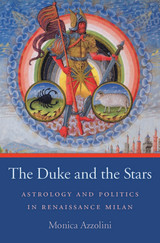
This study is the first to examine the important political role played by astrology in Italian court culture. Reconstructing the powerful dynamics existing between astrologers and their prospective or existing patrons, The Duke and the Stars illustrates how the “predictive art” of astrology was a critical source of information for Italian Renaissance rulers, particularly in times of crisis. Astrological “intelligence” was often treated as sensitive, and astrologers and astrologer-physicians were often trusted with intimate secrets and delicate tasks that required profound knowledge not only of astrology but also of the political and personal situation of their clients. Two types of astrological predictions, medical and political, were taken into the most serious consideration. Focusing on Milan, Monica Azzolini describes the various ways in which the Sforza dukes (and Italian rulers more broadly) used astrology as a political and dynastic tool, guiding them as they contracted alliances, made political decisions, waged war, planned weddings, and navigated health crises.
The Duke and the Stars explores science and medicine as studied and practiced in fifteenth-century Italy, including how astrology was taught in relation to astronomy.


The Dumbarton Oaks Anthology of Chinese Garden Literature is the first comprehensive collection in English of over two millennia of Chinese writing about gardens and landscape. Its contents range from early poems using plant imagery to represent virtue and vice, through works from many dynasties on both private and imperial gardens, to twentieth-century prose descriptions of the reconstruction of a historic Suzhou garden. Most passages have been translated for this publication. A number of previously published translations, some of which are now hard to find, are also included.
The anthology is divided into nine chapters: five chronological, covering the pre-Qin period to the Qing dynasty; and four thematic, on rocks and flora, the evolution of a single site (Canglang Pavilion in Suzhou), gardens of the mind, and the interplay between garden and landscape as seen through Mount Tai and West Lake. An introductory essay positions Chinese gardens and garden literature in their cultural context. Care has been taken to translate plant names as accurately as possible given the limitations of the sources, and the anthology includes a glossary of translated names, Chinese names, and binomials.

In 1944, as the end of World War II approached, an important series of talks was held to plan the formation of postwar international institutions. The site for the conversations was Dumbarton Oaks in Washington, DC, a research institute administered by Harvard University. In a spirit of optimism, Secretary of State Cordell Hull said that the purpose was “to create the institutional foundations for a just and enduring peace,” while Soviet ambassador Andrei Gromyko spoke of an international organization that would “guarantee for the peoples peace, security, and prosperity in the future.” The meetings, which included debates on a variety of issues, were a first step toward the creation of the United Nations.
In 1994, the “Dumbarton Oaks Conference, 1944–1994” brought together scholars and policymakers who have been involved with the study of international organizations or have played important roles in them. The conference papers in this volume examine both the formation of the United Nations and a number of current issues, including human rights, collective economic sanctions, peacekeeping operations, and the evolution of the role of the Secretary-General.








The annual journal Dumbarton Oaks Papers was founded in 1941 for the publication of articles relating to late antique, early medieval, and Byzantine civilization in the fields of art and architecture, history, archeology, literature, theology, law, and the auxiliary disciplines. Numerous maps, tables, illustrations, and color plates provide supplementary information for many of the articles.
In this issue: Kathleen Corrigan, “The Witness of John the Baptist on an Early Byzantine Icon in Kiev”; Ann Terry, “The Sculpture at the Cathedral of Eufrasius in Poreč”; Natalia Teteriatnikov, “Upper-Story Chapels near the Sanctuary in Churches of the Christian East”; Mark J. Johnson, “Toward a History of Theoderic’s Building Program”; Paul Magdalino, “The Bath of Leo the Wise and the ‘Macedonian Renaissance’ Revisited: Topography, Iconography, Ceremonial, Ideology”; Robert W. Edwards, “The Vale of Kola: A Final Preliminary Report on the Marchlands of Northeast Turkey”; Joseph D. C. Frendo, “History and Panegyric in the Age of Heraclius: The Literary Background to the Composition of the Histories of Theophylact Simocatta”; John Meyendorff, “Mount Athos in the Fourteenth Century: Spiritual and Intellectual Legacy”; Nicolas Oikonomides, “Mount Athos: Levels of Literacy”; and Robert F. Taft, S.J., “Mount Athos: A Late Chapter in the History of the Byzantine Rite.”













Dumbarton Oaks Papers is an annual journal of scholarly articles on Byzantine topics. Many of the articles are based upon presentations made at the Byzantine conferences hosted by Dumbarton Oaks. Numerous maps, tables, illustrations, and color plates provide supplementary information.
Dumbarton Oaks Papers 59 includes papers from a colloquium on Byzantine glass, guest edited by David Whitehouse of the Corning Museum of Glass. Other articles feature a discussion of zodiac cycles in ancient Palestinian synagogues, a study of early Christians' responses to the spectacles of fifth-century Carthage, and an analysis of scientific and literary sources pertaining to the mysterious cloud that darkened the sky for about a year in 536, to determine what, if any, immediate effects it had. A fieldwork report on the ongoing excavations at the Amorium project is also featured.

Volume 60 of this annual journal explores a range of Byzantine subjects: the classification of stamping objects (including six previously unpublished metal stamps); the date and purpose of the construction of Constantinople’s church of Saints Sergius and Bacchus; the Coptic Church’s literary construction of its identity in post-conquest Egypt; the evidence for the tenth-century revision of the so-called Chronicle of 811; an unusual development in the iconography of St. Menas; and versions of Niketas Choniates’ History.
Also included are editions and translations of Byzantine Communion prayers newly discovered in Massachusetts and two funerary epigrams written by Manuel Philes; both articles include commentary. The volume concludes with reports from 2003 and 2004 on Dumbarton Oaks–supported archaeological fieldwork projects on a church in Bizye and an aristocratic rock-cut Byzantine settlement in Cappadocia.

This latest volume of Dumbarton Oaks Papers focuses in part on literary and historical texts: historicism in Byzantine thought and literature; the Chronicle of Matthew of Edessa, encompassing the First Crusade and the Armenian diaspora; and a reappraisal of the satirical prose work Mazaris’s Journey to Hades. The history and architecture of the Cypriot Monastery of Saint John Chrysostomos at Koutsovendis occupy a lengthy and informative chapter, which also includes a first edition of the “Letter of Nikon of the Black Mountain to the Founder George.”
The volume also contains selected papers from the 2005 Dumbarton Oaks symposium on the archaeological evidence for settlement patterns in Anatolia and the Levant between 500 and 1000.

This volume begins with a substantial investigation of the murder of several members of the imperial family during the summer of 337, following the death of Constantine. Two other major articles are devoted to well-known Byzantine illustrated manuscripts, the ninth-century Sacra Parallela and the fourteenth-century collection of theological works by the emperor John VI Kantakouzenos, both now in Paris. A third art-historical paper presents a detailed analysis of the architectural decoration of the church of the “Red Monastery” near Suhag in Egypt. Other studies treat the mystery of the Incarnation as well as the earliest version of the Life of the Virgin and its relationship with the cult of Marian relics in Constantinople.
The volume concludes with three papers from a colloquium on the hymnographer Romanos the Melode.

Founded in 1941, the annual journal Dumbarton Oaks Papers is dedicated to the publication of articles relating to late antique, early medieval, and Byzantine civilization in the fields of art and architecture, history, archaeology, literature, theology, law, and auxiliary disciplines.
In this issue: Alexander Sarantis, “War and Diplomacy in Pannonia and the Northwest Balkans during the Reign of Justinian: The Gepid Threat and Imperial Responses”; Peter Hatlie, “Images of Motherhood and Self in Byzantine Literature”; Maria Evangelatou, “Liturgy and the Illustration of the Ninth-Century Marginal Psalters”; Henry Maguire, “Ivories as Pilgrimage Art: A New Frame for the ‘Frame Group’”; Vasileios Marinis, “Tombs and Burials in the Monastery tou Libos in Constantinople”; and three fieldwork reports: “Second Report on the Excavation in the Monastery of Apa Shenute (Dayr Anba Shinuda) at Suhag,” by Peter Grossman, Darlene L. Brooks Hedstrom, and Saad Mohamad Mohamad Osman, with a contribution by Hans-Christoph Noeske; “To Live and Die in a Turbulent Era: Bioarchaeological Analysis of the Early Byzantine (6th–7th Centuries AD) Population from Sourtara Galaniou Kozanis (Northern Greece),” by Chryssi Bourbou; and “Study and Restoration of the Zeyrek Camii in Istanbul: Second Report, 2001–2005,” by Robert Ousterhout, Zeynep Ahunbay, and Metin Ahunbay.



Founded in 1941, the annual journal Dumbarton Oaks Papers is dedicated to the publication of articles relating to late antique, early medieval, and Byzantine civilization in the fields of art and architecture, history, archaeology, literature, theology, law, and auxiliary disciplines.
This issue includes “The Canon Tables of the Psalms: An Unknown Work of Eusebius of Caesarea” by Martin Wallraff; “Histoires ‘Gothiques’ à Byzance: Le Saint, Le Soldat, et Le Miracle d’Euphémie et du Goth (BHG 739)” by Charis Messis and Stratis Papaioannou; “Reassessing the Sarcophagi of Ravenna” by Edward M. Schoolman; “Sources for the Study of Liturgy in Post-Byzantine Jerusalem (638–1187 CE)” by Daniel Galadza; “(Re)Mapping Medieval Antioch: Urban Transformations from the Early Islamic to the Middle Byzantine Periods” by A. Asa Eger; “Melkites and Icon Worship during the Iconoclastic Period” by Juan Signes Codoñer; “The Anzas Family: Members of the Byzantine Civil Establishment in the Eleventh, Twelfth, and Thirteenth Centuries” by John Nesbitt and Werner Seibt; “Viewing and Description in Hysmine and Hysminias: The Fresco of the Virtues” by Paroma Chatterjee; “The Documents of Dominicus Grimani, Notary in Candia (1356–1357)” by Nicky Tsougarakis; and “The Church of Saints Sergius and Bacchus in Kaftūn (Northern Lebanon) and Its Wall Paintings” by Tomasz Waliszewski, Krzysztof Chmielewski, Mat Immerzeel, and Nada Hélou.





Published annually, the journal Dumbarton Oaks Papers was founded in 1941 for the publication of articles relating to Byzantine civilization.
In this issue: Audrey Becker, “Verbal and Nonverbal Diplomatic Communication at the Imperial Court of Constantinople (fifth–sixth Centuries)”; Alexandra Wassiliou-Seibt and Andreas Gkoutzioukostas, “The Origin and the Members of the Kamytzes Family: A Contribution to Byzantine Prosopography”; Michael Zellmann-Rohrer, “‘Psalms Useful for Everything’: Byzantine and Post-Byzantine Manuals for the Amuletic Use of the Psalter”; Raymond Van Dam, “Eastern Aristocracies and Imperial Courts: Constantine’s Half-Brother, Licinius’s Prefect, and Egyptian Grain”; Daniel Caner, “Not a Hospital but a Leprosarium: Basil’s Basilias and an Early Byzantine Concept of the Deserving Poor”; Paul Botley, “Greek Literature in Exile: The Books of Andronicus Callistus, 1475–1476”; Aude Busine, “The Dux and the Nun: Hagiography and the Cult of Artemios and Febronia in Constantinople”; Benjamin Garstad, “Dionysiac and Christian Elements in the Lysos Episode in the Greek Alexander Romance (β rec.).”

Published annually, the journal Dumbarton Oaks Papers was founded in 1941 for the publication of articles relating to Byzantine civilization.
In this issue: Walter E. Kaegi, “Irfan Shahîd (1926–2016)”; Daniel Galadza, “Robert F. Taft, S.J. (1932–2018)”; Sylvain Destephen, “From Mobile Center to Constantinople: The Birth of Byzantine Imperial Government”; Dina Boero, “Making a Manuscript, Making a Cult: Scribal Production of the Syriac Life of Symeon the Stylite in Late Antiquity”; Alexandre M. Roberts, “Framing a Middle Byzantine Alchemical Codex”; Lilia Campana, “Sailing into Union: The Byzantine Naval Convoy for the Council of Ferrara–Florence (1438–1439)”; Hugh G. Jeffery, “New Lead Seals from Aphrodisias”; Maria G. Parani, “Curtains in the Middle and Late Byzantine House”; Kostis Kourelis, “Wool and Rubble Walls: Domestic Archaeology in the Medieval Peloponnese”; Kathrin Colburn, “Loops, Tabs, and Reinforced Edges: Evidence for Textiles as Architectural Elements”; Eunice Dauterman Maguire, “Curtains at the Threshold: How They Hung and How They Performed”; Sabine Schrenk, “The Background of the Enthroned: Spatial Analysis of the Hanging with Hestia Polyolbos in the Dumbarton Oaks Collection”; Jennifer L. Ball, “Rich Interiors: The Remnant of a Hanging from Late Antique Egypt in the Collection of Dumbarton Oaks”; Maria Evangelatou, “Textile Mediation in Late Byzantine Visual Culture: Unveiling Layers of Meaning through the Fabrics of the Chora Monastery”; Thelma K. Thomas, “The Honorific Mantle as Furnishing for the Household Memory Theater in Late Antiquity: A Case Study from the Monastery of Apa Apollo at Bawit”; Avinoam Shalem, “‘The Nation Has Put On Garments of Blood’: An Early Islamic Red Silken Tapestry in Split”; and Elizabeth Dospěl Williams, “A Taste for Textiles: Designing Ummayad and Early ʿAbbāsid Interiors.”

Published annually, the journal Dumbarton Oaks Papers was founded in 1941 for the publication of articles relating to Byzantine civilization.
In this issue: John S. Langdon and Stephen W. Reinert, “Speros Vryonis Jr.: 1928–2019”; Abraham Terian, “Monastic Turmoil in Sixth-Century Jerusalem and the South Caucasus: The Letter of Patriarch John IV to Catholicos Abas of the Caucasian Albanians”; Coleman Connelly, “Continued Celebration of the Kalends of January in the Medieval Islamic East”; Victoria Gerhold, “The Legend of Euphratas: Some Notes on Its Origins, Development, and Significance”; Christos Simelidis, “Two Lives of the Virgin: John Geometres, Euthymios the Athonite, and Maximos the Confessor”; Georgios Makris, “Living in Turbulent Times: Monasteries, Settlements, and Laypeople in Late Byzantine Southwest Thrace”; Philipp Niewöhner, “The Significance of the Cross before, during, and after Iconoclasm: Early Christian Aniconism in Constantinople and Asia Minor”; Stefania Gerevini, “Art as Politics in the Baptistery and Chapel of Sant’Isidoro at San Marco, Venice”; Laura Pfuntner, “Between Science and Superstition: Photius, Diodorus Siculus, and ‘Hermaphrodites’”; Baukje van den Berg, “John Tzetzes as Didactic Poet and Learned Grammarian”; Matthew Kinloch, “In the Name of the Father, the Husband, or Some Other Man: The Subordination of Female Characters in Byzantine Historiography”; Levente László, “Rhetorius, Zeno’s Astrologer, and a Sixth-Century Astrological Compendium”; and Stig Simeon R. Frøyshov, “The Early History of the Hagiopolitan Daily Office in Constantinople: New Perspectives on the Formative Period of the Byzantine Rite.”

Published annually, the journal Dumbarton Oaks Papers was founded in 1941 for the publication of articles relating to Byzantine civilization.
In this issue: Margaret Mullet, “Ruth Juliana Macrides: 1949–2019”; Sihong Lin, “Justin under Justinian: The Rise of Emperor Justin II Revisited”; David Gyllenhaal, “Byzantine Melitene and the Social Milieu of the Syriac Renaissance”; Pavel Murdzhev, “The Introduction of the Moldboard Plow to Byzantine Thrace in the Eleventh Century”; Annemarie Weyl Carr, “The Lady and the Juggler: Mary East and West”; Robert S. Nelson, “A Miniature Mosaic Icon of St. Demetrios in Byzantium and the Renaissance”; Esra Akin-Kivanç, “In the Mirror of the Other: Imprints of Muslim–Christian Encounters in the Late Antique and Early Medieval Mediterranean”; Anna Chrysostomides, “John of Damascus’s Theology of Icons in the Context of Eighth-Century Palestinian Iconoclasm”; Max Ritter, “The Byzantine Afterlife of Procopius’s Buildings”; Jonathan L. Zecher, “Myths of Aerial Tollhouses and Their Tradition from George the Monk to the Life of Basil the Younger”; Nektarios Zarras, “Illness and Healing: Τhe Ministry Cycle in the Chora Monastery and the Literary Oeuvre of Theodore Metochites”; and Aleksandr Andreev, “The Order of the Hours in the Yaroslavl Horologion.”

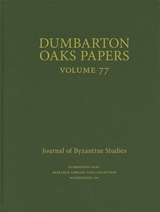

Dumbarton Oaks houses the extraordinary art collection begun by Mildred and Robert Woods Bliss. In this book the museum publishes the specialist collections in Byzantine and Pre-Columbian art, along with examples from the Blisses’ superb European collection, for the first time.
When Robert Bliss recalled handling a jade Olmec figurine in 1913, he said, “That day, the collector’s microbe took root in—it must be confessed—very fertile soil.” The Blisses’ passion for art bore fruit in a remarkably diverse collection: Flemish tapestries, Renaissance furniture, and paintings by the likes of El Greco, Renoir, and Degas. The celebrated Byzantine collection includes floor mosaics from late antique Antioch, sumptuous jewelry, carved ivory reliefs, liturgical silver, and a comprehensive coin and seals collection. The Pre-Columbian collection showcases fine jade carvings, gold jewelry, monumental sculpture, ritual weaponry, colorful ceramics, and intricately woven textiles.
The publication of this new guidebook coincides with the complete refurbishment of Dumbarton Oaks and the creative reinstallation of the galleries. The curators offer highlights of the collection, accompanied by a lucid and thought-provoking text. Dumbarton Oaks: The Collections is intended as a valuable resource and a pleasure to read for scholars and nonspecialists alike.


In May of 1940, the armies of Nazi Germany were marching through France. In the face of this devastating advance, one of World War II’s greatest acts of heroism would be a retreat: the evacuation of the British Army from Dunkirk.
In Dunkirk: Fight to the Last Man, we are given an unprecedented vision of these harrowing days. Hugh Sebag-Montefiore has created a bold and powerful account of the small group of men who fended off the German army so that hundreds of thousands of their comrades could exit this doomed land. These brave troops, members of the British Expeditionary Forces and the French army, held a series of strong points inland, allowing the rest of the battered battalions to escape to the coast. Those that remained were ordered to fight to the last man.
Much has been written about the efforts of the Royal Navy in shuttling soldiers to safety, but here we are given an unparalleled look inside this massive operation and the invaluable role played by the BEF. Without the ferocity and bravery of the officers and ordinary soldiers on the ground, the German army would likely have encircled nearly half a million Allied soldiers. The loss of these battalions, Sebag-Montefiore argues, could have dramatically changed the direction of the war, and enabled Hitler to invade a weakened Britain.
This is military history at its best: a judicious analysis of the movement of the war, and a vivid feel of what it was like to be on the front line. Sebag-Montefiore brings these men—the forgotten heroes of Dunkirk—to life, and it is their valiant exploits and devotion to their brethren that form the heart of this important book.


"How much history can be communicated by pressure on a guitar string?" Robert Palmer wondered in Deep Blues. Greil Marcus answers here: more than we will ever know. It is the history in the riff, in the movie or novel or photograph, in the actor's pose or critic's posturing--in short, the history in cultural happenstance--that Marcus reveals here, exposing along the way the distortions and denials that keep us oblivious if not immune to its lessons.
Whether writing about the Beat Generation or Umberto Eco, Picasso's Guernica or the massacre in Tiananmen Square, The Manchurian Candidate or John Wayne's acting, Eric Ambler's antifascist thrillers or Camille Paglia, Marcus uncovers the histories embedded in our cultural moments and acts, and shows how, through our reading of the truths our culture tells and those it twists and conceals, we situate ourselves in that history and in the world. Rarely has a history lesson been so exhilarating. With the startling insights and electric style that have made him our foremost writer on American music, Marcus brings back to life the cultural events that have defined us and our time, the social milieu in which they took place, and the individuals engaged in them. As he does so, we see that these cultural instances--as lofty as The Book of J, as humble as a TV movie about Jan and Dean, as fleeting as a few words spoken at the height of the Berkeley Free Speech Movement, as enduring as a Paleolithic painting--often have more to tell us than the master-narratives so often passed off as faultless representations of the past.
Again and again Marcus skewers the widespread assumption that history exists only in the past, that it is behind us, relegated to the dustbin. Here we see instead that history is very much with us, being made and unmade every day, and unless we recognize it our future will be as cramped and impoverished as our present sense of the past.

In 1988–1989 the three hundredth anniversary of an important historical event, the ascension of William and Mary to the thrones of England and Scotland, was celebrated in the Netherlands, the United Kingdom, and the United States of America. The symposium on Dutch garden art held at Dumbarton Oaks in May 1988 was the only scholarly event during the anniversary year that focused wholly upon gardens.
This wide-ranging collection of essays charts the history, scope, and spread of Dutch garden art during the seventeenth century. A group of scholars, mostly Dutch, surveys what has been called the “golden age” of Dutch garden design. Essays discuss the political context of William’s building and gardening activities at his palace of Het Loo in the Netherlands; the development of a distinctively Dutch garden art during the seventeenth century; country house poetry; and specific estates and their gardens, such as those of Johan Maurits van Nassau-Siegen at Cleves or Sorgvliet, the estate of Hans Willem Bentinck, later the Earl of Portland. Other contributions concern typical Dutch planting and layouts, with a focus upon Jan van der Green’s much-circulated Den Nederlandtsen Hovenier; the designs of Daniel Marot, the Huguenot refugee from France, who worked for William III in both the Netherlands and England; and the attitudes of the English toward Dutch gardening as it was observed in practice and mythologized through the distorting lens of national cooperation and rivalries.
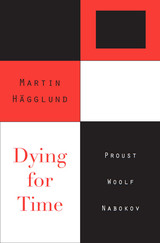
Marcel Proust, Virginia Woolf, and Vladimir Nabokov transformed the art of the novel in order to convey the experience of time. Nevertheless, their works have been read as expressions of a desire to transcend time—whether through an epiphany of memory, an immanent moment of being, or a transcendent afterlife. Martin Hägglund takes on these themes but gives them another reading entirely. The fear of time and death does not stem from a desire to transcend time, he argues. On the contrary, it is generated by the investment in temporal life. From this vantage point, Hägglund offers in-depth analyses of Proust’s Recherche, Woolf’s Mrs. Dalloway, and Nabokov’s Ada.
Through his readings of literary works, Hägglund also sheds new light on topics of broad concern in the humanities, including time consciousness and memory, trauma and survival, the technology of writing and the aesthetic power of art. Finally, he develops an original theory of the relation between time and desire through an engagement with Freud and Lacan, addressing mourning and melancholia, pleasure and pain, attachment and loss. Dying for Time opens a new way of reading the dramas of desire as they are staged in both philosophy and literature.
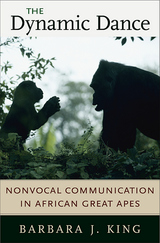
Mother and infant negotiate over food; two high-status males jockey for power; female kin band together to get their way. It happens among humans and it happens among our closest living relatives in the animal kingdom, the great apes of Africa. In this eye-opening book, we see precisely how such events unfold in chimpanzees, bonobos, and gorillas: through a spontaneous, mutually choreographed dance of actions, gestures, and vocalizations in which social partners create meaning and come to understand each other.
Using dynamic systems theory, an approach employed to study human communication, Barbara King is able to demonstrate the genuine complexity of apes' social communication, and the extent to which their interactions generate meaning. As King describes, apes create meaning primarily through their body movements--and go well beyond conveying messages about food, mating, or predators. Readers come to know the captive apes she has observed, and others across Africa as well, and to understand "the process of creating social meaning."
This new perspective not only acquaints us with our closest living relatives, but informs us about a possible pathway for the evolution of language in our own species. King's theory challenges the popular idea that human language is instinctive, with rules and abilities hardwired into our brains. Rather, The Dynamic Dance suggests, language has its roots in the gestural "building up of meaning" that was present in the ancestor we shared with the great apes, and that we continue to practice to this day.

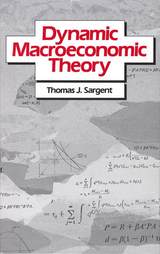
The tasks of macroeconomics are to interpret observations on economic aggregates in terms of the motivations and constraints of economic agents and to predict the consequences of alternative hypothetical ways of administering government economic policy. General equilibrium models form a convenient context for analyzing such alternative government policies. In the past ten years, the strengths of general equilibrium models and the corresponding deficiencies of Keynesian and monetarist models of the 1960s have induced macroeconomists to begin applying general equilibrium models.
This book describes some general equilibrium models that are dynamic, that have been built to help interpret time-series of observations of economic aggregates and to predict the consequences of alternative government interventions. The first part of the book describes dynamic programming, search theory, and real dynamic capital pricing models. Among the applications are stochastic optimal growth models, matching models, arbitrage pricing theories, and theories of interest rates, stock prices, and options. The remaining parts of the book are devoted to issues in monetary theory; currency-in-utility-function models, cash-in-advance models, Townsend turnpike models, and overlapping generations models are all used to study a set of common issues. By putting these models to work on concrete problems in exercises offered throughout the text, Thomas Sargent provides insights into the strengths and weaknesses of these models of money. An appendix on functional analysis shows the unity that underlies the mathematics used in disparate areas of rational expectations economics.
This book on dynamic equilibrium macroeconomics is suitable for graduate-level courses; a companion book, Exercises in Dynamic Macroeconomic Theory, provides answers to the exercises and is also available from Harvard University Press.

Contrary to traditional theories of statutory interpretation, which ground statutes in the original legislative text or intent, legal scholar William Eskridge argues that statutory interpretation changes in response to new political alignments, new interpreters, and new ideologies. It does so, first of all, because it involves richer authoritative texts than does either common law or constitutional interpretation: statutes are often complex and have a detailed legislative history. Second, Congress can, and often does, rewrite statutes when it disagrees with their interpretations; and agencies and courts attend to current as well as historical congressional preferences when they interpret statutes. Third, since statutory interpretation is as much agency-centered as judge-centered and since agency executives see their creativity as more legitimate than judges see theirs, statutory interpretation in the modern regulatory state is particularly dynamic.
Eskridge also considers how different normative theories of jurisprudence—liberal, legal process, and antiliberal—inform debates about statutory interpretation. He explores what theory of statutory interpretation—if any—is required by the rule of law or by democratic theory. Finally, he provides an analytical and jurisprudential history of important debates on statutory interpretation.

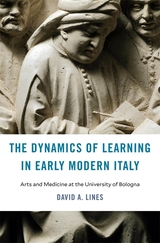
A pathbreaking history of early modern education argues that Europe’s oldest university, often seen as a bastion of traditionalism, was in fact a vibrant site of intellectual innovation and cultural exchange.
The University of Bologna was among the premier universities in medieval Europe and an international magnet for students of law. However, a long-standing historiographical tradition holds that Bologna—and Italian university education more broadly—foundered in the early modern period. On this view, Bologna’s curriculum ossified and its prestige crumbled, due at least in part to political and religious pressure from Rome. Meanwhile, new ways of thinking flourished instead in humanist academies, scientific societies, and northern European universities.
David Lines offers a powerful counternarrative. While Bologna did decline as a center for the study of law, he argues, the arts and medicine at the university rose to new heights from 1400 to 1750. Archival records show that the curriculum underwent constant revision to incorporate contemporary research and theories, developed by the likes of René Descartes and Isaac Newton. From the humanities to philosophy, astronomy, mathematics, and medicine, teaching became more systematic and less tied to canonical texts and authors. Theology, meanwhile, achieved increasing prominence across the university. Although this religious turn reflected the priorities and values of the Catholic Reformation, it did not halt the creation of new scientific chairs or the discussion of new theories and discoveries. To the contrary, science and theology formed a new alliance at Bologna.
The University of Bologna remained a lively hub of cultural exchange in the early modern period, animated by connections not only to local colleges, academies, and libraries, but also to scholars, institutions, and ideas throughout Europe.


The importance of the rich corpus of “Masters Literature” that developed in early China since the fifth century BCE has long been recognized. But just what are these texts? Scholars have often approached them as philosophy, but these writings have also been studied as literature, history, and anthropological, religious, and paleographic records. How should we translate these texts for our times?
This book explores these questions through close readings of seven examples of Masters Literature and asks what proponents of a “Chinese philosophy” gained by creating a Chinese equivalent of philosophy and what we might gain by approaching these texts through other disciplines, questions, and concerns. What happens when we remove the accrued disciplinary and conceptual baggage from the Masters Texts? What neglected problems, concepts, and strategies come to light? And can those concepts and strategies help us see the history of philosophy in a different light and engender new approaches to philosophical and intellectual inquiry? By historicizing the notion of Chinese philosophy, we can, the author contends, answer not only the question of whether there is a Chinese philosophy but also the more interesting question of the future of philosophical thought around the world.

Brian Skyrms constructs a theory of “dynamic deliberation” and uses it to investigate rational decision-making in cases of strategic interaction. This illuminating book will be of great interest to all those in many disciplines who use decision theory and game theory to study human behavior and thought.
Skyrms begins by discussing the Bayesian theory of individual rational decision and the classical theory of games, which at first glance seem antithetical in the criteria used for determining action. In his effort to show how methods for dealing with information feedback can be productively combined, the author skillfully leads us through the mazes of equilibrium selection, the Nash equilibria for normal and extensive forms, structural stability, causal decision theory, dynamic probability, the revision of beliefs, and, finally, good habits for decision.
The author provides many clarifying illustrations and a handy appendix called “Deliberational Dynamics on Your Personal Computer.” His powerful model has important implications for understanding the rational origins of convention and the social contract, the logic of nuclear deterrence, the theory of good habits, and the varied strategies of political and economic behavior.

The Dynamics of Soviet Politics is the result of reflective and thorough research into the centers of a system whose inner debates are not open to public discussion and review, a system which tolerates no public opposition parties, no prying congressional committees, and no investigative journalists to ferret out secrets. The expert authors offer an inside view of the workings of this closed system a view rarely found elsewhere in discussions of Soviet affairs. Their work, building as it does on the achievements of Soviet studies over the last thirty years, is firmly rooted in established knowledge and covers sufficient new ground to enable future studies of Soviet politics and social practices to move ahead unencumbered by stereotypes, sensationalism, or mystification.
Among the subjects included are: attitudes toward leadership and a general discussion of the uses of political history; the dramatic cycles of officially permitted dissent; the legitimacy of leadership within a system that has no constitutional provision for succession; the gradual adoption of Western-inspired administrative procedures and "systems management"; a study of group competition, and bureaucratic bargaining; Khrushchev's virgin-lands experiment and its subsequent retrenchment; the apolitical values of adolescents; the problems of integrating Central Asia into the Soviet system; a history of peaceful coexistence and its current importance in Soviet foreign policy priorities, and, finally, an overview of Soviet government as an extension of prerevolutionary oligarchy, with an emphasis on adaptation to political change.
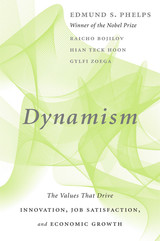
Nobel Laureate Edmund Phelps and an international group of economists argue that economic health depends on the widespread presence of certain values, in particular individualism and self-expression.
Nobel Laureate Edmund Phelps has long argued that the high level of innovation in the lead nations of the West was never a result of scientific discoveries plus entrepreneurship, as Schumpeter thought. Rather, modern values—particularly the individualism, vitalism, and self-expression prevailing among the people—fueled the dynamism needed for widespread, indigenous innovation. Yet finding links between nations’ values and their dynamism was a daunting task. Now, in Dynamism, Phelps and a trio of coauthors take it on.
Phelps, Raicho Bojilov, Hian Teck Hoon, and Gylfi Zoega find evidence that differences in nations’ values matter—and quite a lot. It is no accident that the most innovative countries in the West were rich in values fueling dynamism. Nor is it an accident that economic dynamism in the United States, Britain, and France has suffered as state-centered and communitarian values have moved to the fore.
The authors lay out their argument in three parts. In the first two, they extract from productivity data time series on indigenous innovation, then test the thesis on the link between values and innovation to find which values are positively and which are negatively linked. In the third part, they consider the effects of robots on innovation and wages, arguing that, even though many workers may be replaced rather than helped by robots, the long-term effects may be better than we have feared. Itself a significant display of creativity and innovation, Dynamism will stand as a key statement of the cultural preconditions for a healthy society and rewarding work.

This volume addresses cultural and literary transformation in the late Ming (1550-1644) and late Qing (1851-1911) eras. Although conventionally associated with a devastating sociopolitical crisis, each of these periods was also a time when Chinese culture was rejuvenated. Focusing on the twin themes of crisis and innovation, the seventeen chapters in this book aim to illuminate the late Ming and late Qing as eras of literary-cultural innovation during periods of imperial disintegration; to analyze linkages between the two periods and the radical heritage they bequeathed to the modern imagination; and to rethink the "premodernity" of the late Ming and late Qing in the context of the end of the age of modernism.
The chapters touch on a remarkably wide spectrum of works, some never before discussed in English, such as poetry, drama, full-length novels, short stories, tanci narratives, newspaper articles, miscellanies, sketches, familiar essays, and public and private historical accounts. More important, they intersect on issues ranging from testimony about dynastic decline to the negotiation of authorial subjectivity, from the introduction of cultural technology to the renewal of literary convention.


Dyslexia and Development presents the latest findings of neurobiological research, which suggest a link between seemingly minor brain abnormalities and epilepsy, learning disorders, and autism. The authors focus on the plasticity of the developing nervous system and the possible role of subtle early brain injury in the emergence of these disorders, particularly dyslexia.
The distinguished contributors to this volume examine epidemiological and clinical issues that may make the developing brain more vulnerable to environmental and genetic influences, which can in turn lead to abnormal brain plasticity and behavior. Although major forms of brain malformation have been clearly associated with functional deficits, mild forms have historically been ignored or trivialized; this book supports the hypothesis that several types of such malformation reflect brain injury during critical stages of development, and also the premise that more and more disturbances of thought and behavior stem from abnormalities of brain organization.
Neurologists and neurobiologists, psychologists, psycholinguists, psychiatrists, and special educators will find here a guide to more enlightened understanding and more effective treatment of dyslexia. In fact, the book emphasizes the positive aspect of the neurobiological deviation that dyslexic brains seem to show, along with the observation that people with such brains are often quite creative and extraordinary, rather than handicapped. In turn, the revised consideration of dyslexia should lead to more serious attention to other disturbances of childhood behavior as problems in developmental neurology, as well as to a deeper analysis of possible neurological bases for individual differences in normal behavior and personality.
READERS
Browse our collection.
PUBLISHERS
See BiblioVault's publisher services.
STUDENT SERVICES
Files for college accessibility offices.
UChicago Accessibility Resources
home | accessibility | search | about | contact us
BiblioVault ® 2001 - 2024
The University of Chicago Press


